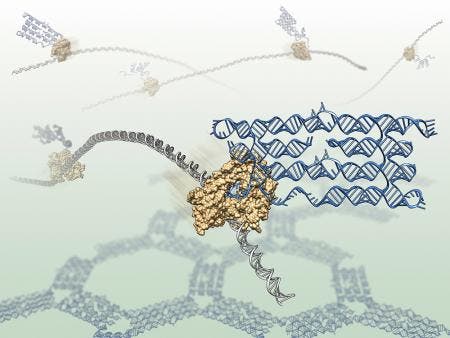A team of researchers from the Aarhus University in Denmark and CalTech has developed an origami-inspired method of organizing molecules on the nanoscale. The team has modeled RNA, DNA’s close cousin into complicated shapes using the technique.

This illustration is an artist’s impression of RNA nanostructures that fold up while they are being synthesized by polymerase enzymes. Image credits: Cody Geary.
Together with DNA, RNA comprises the nucleic acids, which, along with proteins, constitute the three major macromolecules essential for all known forms of life. DNA origami is not a novel technique, but RNA origami is, and the process of creating the two is fundamentally different. While with DNA, you chemically synthesize it and then arrange it into any shape you want, with RNA, you have to fold up its components as you synthesize them – under conditions similar to living organisms. These features of RNA origami may allow designer RNA structures to be grown within living cells.
“The parts for a DNA origami cannot easily be written into the genome of an organism. An RNA origami, on the other hand, can be represented as a DNA gene, which in cells is transcribed into RNA by a protein machine called RNA polymerase,” explains Paul Rothemund, a senior research associate in computation and neural systems in the Division of Engineering and Applied Science at Caltech.
They first demonstrated the technique by assembling RNA into rectangles, and then assembled the rectangles in a honeycomb-like pattern.
“What is unique about the method is that the folding recipe is encoded into the molecule itself, through its sequence.” explains first author Cody Geary, a postdoctoral scholar at Aarhus University.
This means that the shape of the resulting RNA is actually determined by the synthesized RNA sequence. This can have a myriad of potential applications in biology, most notably in protein delivery.
RNA has a richer structural and functional repertoire than DNA, and so I am especially interested in how complex biological motifs with special 3-D geometries or protein-binding regions can be added to the basic architecture of RNA origami,” says Geary, who completed his BS in chemistry at Caltech in 2003.
Also, unlike DNA origami, RNA can be made much more cheaper and faster, which makes it even more interesting:
“The payoff is that unlike DNA origami, which are expensive and have to be made outside of cells, RNA origami should be able to be grown cheaply in large quantities, simply by growing bacteria with genes for them,” he adds. “Genes and bacteria cost essentially nothing to share, and so RNA origami will be easily exchanged between scientists.”
Origami techniques have gotten a lot of attention in science lately. Aside for the DNA manipulation technique, we’ve seen several types of origami robots, including DNA nanobots, space shuttles, and even origami microscopes. Personally, I find the mixture of art and science remarkable in general, and even more so in this case.









